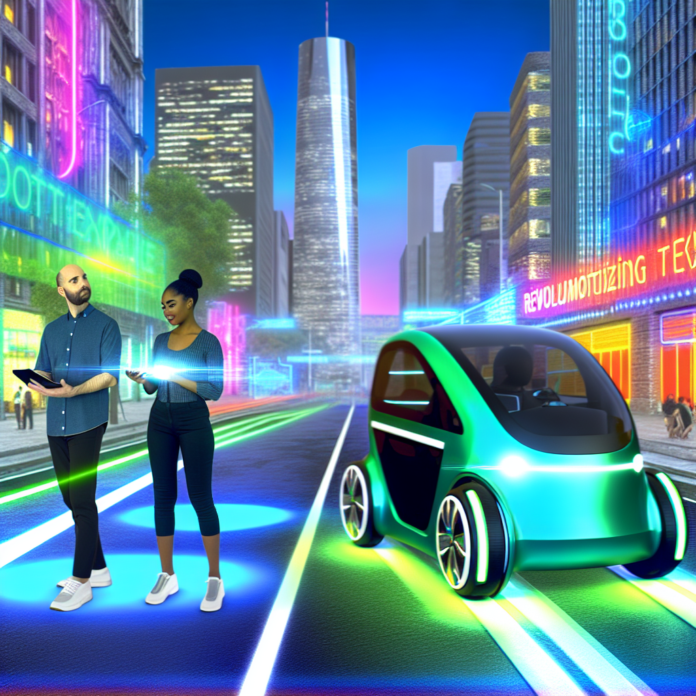Revolutionizing Travel: How Autonomous EVs Are Shaping the Future of Mobility
Imagine navigating busy city streets without ever touching the wheel. Picture a world where your vehicle knows your destination, plans the fastest route, and even avoids traffic jams—all while you kick back and enjoy your favorite podcast or game. This isn’t some distant dream; it’s the exhilarating reality brought to us by the rise of autonomous electric vehicles (EVs). These innovative machines are not only transforming how we travel but are also setting the stage for a revolution in mobility. Let’s explore how autonomous EVs are changing the game and what that means for our daily lives.
Why Autonomous EVs Matter
Auto-piloted cars were once the stuff of science fiction, but today they’re increasingly becoming a part of our daily lives. With concerns about climate change and urban congestion, the integration of electric vehicles with autonomous driving technology serves a dual purpose: reducing our carbon footprint while enhancing safety and efficiency on the roads. According to a study by the International Energy Agency, the share of electric vehicles in total car sales has surged, and it’s expected to continue on an upward trajectory. Combine that with advancements in artificial intelligence, and you have the perfect storm for a transportation overhaul.
Real-World Applications: Where the Rubber Meets the Road
While the future sounds exciting, autonomous EVs are not merely theoretical concepts. They are already on our streets! Companies like Waymo and Tesla are leading the charge, introducing self-driving ride-hailing services. Imagine ordering a ride from your smartphone and having a fully autonomous vehicle show up at your doorstep. No driver, just a sleek electric car ready to whisk you away. In places like San Francisco, Waymo has already rolled out its autonomous taxi services, where passengers can enjoy rides without any human intervention.
Moreover, delivery companies are also embracing this technology. Last-mile delivery is often a headache for logistics, but companies are experimenting with autonomous delivery vans and drones that can efficiently transport goods from warehouses to your door, all while minimizing fuel costs. Just consider a typical Saturday morning: as you sip your coffee and game on your console, an autonomous vehicle drops off that new game you ordered the night before.
The Safety Factor: A Safer Future?
One of the significant benefits touted by advocates of autonomous EV technology is enhanced safety. According to data from the National Highway Traffic Safety Administration, over 90% of traffic accidents are caused by human error. With sophisticated sensors, cameras, and AI, autonomous vehicles promise to mitigate these risks. They can react to obstacles much faster than humans and maintain a constant watch on surrounding traffic. Think of them as the ultimate gaming AIs, analyzing the road conditions in real-time to ensure a smooth experience.
Take incidents where confusion often arises—such as navigating roundabouts or responding to unexpected pedestrians. Where a human driver might hesitate, an autonomous vehicle’s algorithm can evaluate and react in microseconds. As this technology becomes more prevalent, the hope is that we could see a marked decrease in road accidents, translating to safer travel for everyone involved.
Environmental Impact: Driving Towards Sustainability
Electric vehicles already benefit the environment by reducing emissions, and combining them with autonomous technology amplifies this effect. With their optimized navigation systems, autonomous EVs can reduce energy consumption by choosing more efficient routes and reducing speed fluctuations. In urban areas, this means less air pollution and less noise, which contributes not only to a healthier populace but also a more pleasant atmosphere for everyone.
Consider a city where autonomous EVs are the norm. Public transport becomes so efficient that personal car ownership declines. Fewer cars on the road might mean that parking spaces can be converted into parks or community spaces. The environmental opportunities are enormous, echoing beyond just the power behind the vehicles.
Challenges Ahead: The Roadblocks to Implementation
Of course, with great advancements come significant challenges. The technology for safe, reliable autonomous vehicles is constantly evolving, but hurdles remain. Regulatory frameworks lag behind innovations, with policymakers still grappling with how to integrate these vehicles into existing traffic paradigms. Moreover, public perception can also be a barrier; many remain skeptical about the reliability of autonomous systems, often fueled by high-profile accidents involving self-driving cars.
Additionally, the infrastructure needs of a fully autonomous future present another challenge. Roads, signage, and other traffic-related systems will require upgrades to accommodate this new wave of technology. It’s akin to upgrading from an old-school gaming console to the latest high-tech system; to get the most out of the experience, everything needs to work in harmony.
The Future is Now: Embracing Autonomous EVs
As the realm of mobility evolves, so too must our perspective on travel. The advent of autonomous EVs offers exciting prospects for convenience, safety, and environmental sustainability. Whether you’re a hardcore gamer who loves gaming on the go or a tech enthusiast eager for societal advancements, there’s no denying the positive implications these vehicles hold.
So, whether you’re gaming in your living room or catching up with your favorite series, imagine the effortless transition from one point to another with just a tap on your screen. The future isn’t just coming; it’s already paved with electric and autonomous innovations that stand to redefine what it means to journey from place to place.
Isn’t it an exciting time to think about the streets we’ll navigate tomorrow? With autonomous EVs shaping our world, a smooth, efficient, and eco-friendly future awaits.
To learn more about the fascinating world of autonomous vehicles and their implications for your daily life, visit Electric Vehicle News and explore the latest advancements in technology.

